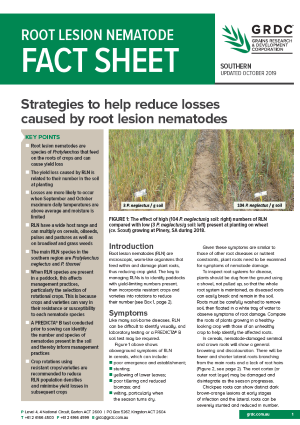Root Lesion Nematode - Southern
Root Lesion Nematode - Southern
Published: 01 Oct 2019
Root lesion nematodes (RLN) are microscopic, worm-like organisms that feed within and damage plant roots, thus reducing crop yield. The key to managing RLNs is to identify paddocks with yield-limiting numbers present, then incorporate resistant crops and varieties into rotations to reduce their number.
Key Points
- Root lesion nematodes are species of Pratylenchus that feed on the roots of crops and can cause yield loss
- The yield loss caused by RLN is related to their number in the soil at planting
- Losses are more likely to occur when September and October maximum daily temperatures are above average and moisture is limited
- RLN have a wide host range and can multiply on cereals, oilseeds, pulses and pastures as well as on broadleaf and grass weeds
- The main RLN species in the southern region are Pratylenchus neglectus and P. thornei
- When RLN species are present in a paddock, this affects management practices, particularly the selection of rotational crops. This is because crops and varieties can vary in their resistance or susceptibility to each nematode species
- A PREDICTA® B test conducted prior to sowing can identify the number and species of nematodes present in the soil and thereby inform management practices
- Crop rotations using resistant crops/varieties are ecommended to reduce RLN population densities and minimise yield losses in subsequent crops.
Download PDF
Region: South
GRDC Project Code: DAV1703-012RMX,

